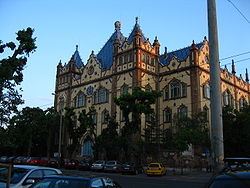
Geological Museum (Budapest)
Encyclopedia

Geology
Geology is the science comprising the study of solid Earth, the rocks of which it is composed, and the processes by which it evolves. Geology gives insight into the history of the Earth, as it provides the primary evidence for plate tectonics, the evolutionary history of life, and past climates...
in Hungary
Hungary
Hungary , officially the Republic of Hungary , is a landlocked country in Central Europe. It is situated in the Carpathian Basin and is bordered by Slovakia to the north, Ukraine and Romania to the east, Serbia and Croatia to the south, Slovenia to the southwest and Austria to the west. The...
. It is located on the Stefánia utca in the western part of Pest
Pest (city)
Pest is the eastern, mostly flat part of Budapest, Hungary, comprising about two thirds of the city's territory. It is divided from Buda, the other part of Budapest, by the Danube River. Among its most notable parts are the Inner City, including the Hungarian Parliament, Heroes' Square and...
.
The building was originally the home of the Hungarian Geological Society, which was established in 1869. The building was designed by Ödön Lechner
Ödön Lechner
Ödön Lechner was a Hungarian architect, nicknamed the "Hungarian Gaudí".Lechner was one of the early representatives of the Hungarian Secession movement, called szecesszió in Hungarian, which was related to Art Nouveau and Jugendstil in the rest of Europe...
in 1896. It still houses the Geological Institute of Hungary.
Its collection consists of minerals, prehistoric footprints, general information on Hungarian geology and its history, and an exhibition dedicated to the building's architect, Ödön Lechner.

